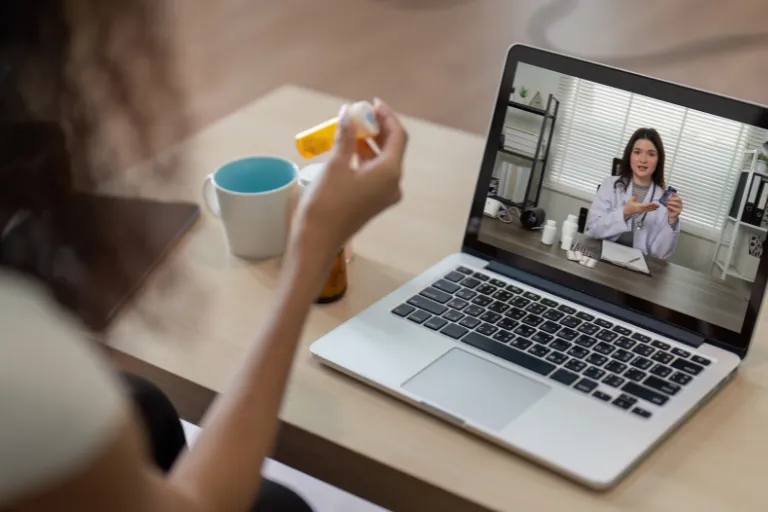Key Points
- Modern technology is transforming how depressive states are managed and supported.
- Evidence-based solutions include teletherapy platforms, mental health apps, wearable trackers, virtual reality, and AI-driven support systems.
- Experts stress that these tools complement—not replace—professional guidance and traditional therapies.
A Digital Lifeline for Mental Health
What if your phone, smartwatch, or VR headset could help lift the weight of a depressive state? For millions, that’s not a far-off idea but a daily reality. The World Health Organization estimates that depressive states affect more than 280 million people worldwide. Yet access to traditional therapy remains limited by cost, geography, and stigma.
“Technology is not about replacing the human relationship in therapy,” explains Dr. Lauren Nguyen, a psychiatrist at Stanford University. “It’s about expanding the reach of care and giving people additional tools they can use between sessions.”
Why Digital Solutions Matter for Depressive States
When left unaddressed, depressive states ripple into every corner of life—work, relationships, and physical health. Traditional therapies and medications remain the backbone of care, but they don’t reach everyone. Technology offers a way to close that gap, providing scalable, evidence-informed solutions that can adapt to daily life.
1. Teletherapy Platforms: Expanding Access Beyond the Office
Teletherapy platforms connect users to licensed health professionals via secure video, chat, or phone calls. What began as a necessity during the pandemic has now become a preferred option for many. Research shows teletherapy can be just as effective as in-person therapy for many users experiencing depressive states [1].
- Strengths: Increases access for rural or underserved areas, reduces stigma, and offers flexible scheduling.
- Limitations: Requires stable internet and may not fully address complex cases.
“Teletherapy has shifted the power balance,” says Dr. Michael Harper, a clinical psychologist in New York. “It’s made care more user-centered, meeting people where they are instead of forcing them into rigid systems.”
2. Mental Health Apps: Everyday Tools for Self-Management
Mental health apps put guided exercises, mood trackers, and evidence-based practices directly in people’s pockets. Apps like Moodfit or Headspace help users build small daily habits that reinforce resilience.
Studies suggest consistent app use can reduce mild to moderate depressive symptoms [2]. Still, experts urge caution. “Not all apps are built on science,” warns Dr. Aisha Cole, a digital health researcher. “It’s important to choose platforms that have been tested and shown to work.”
- Strengths: Always accessible, cost-effective, and supportive of daily engagement.
- Limitations: Privacy concerns and uneven scientific quality across apps.
3. Wearable Devices: Turning Data Into Mental Health Insights
Wearable devices like smartwatches now do more than count steps—they can monitor heart rate variability, sleep quality, and physical activity. These digital biomarkers often correlate with mood and energy shifts, offering clues about mental well-being [3].
“Wearables give us a mirror into how lifestyle and stress affect our mental state,” notes Dr. Karen Li, a neuroscientist at McGill University. “But the key is interpreting that data with context, ideally alongside guidance from a health professional.”
- Strengths: Personalized insights, real-time feedback, integration with wellness platforms.
- Limitations: Risk of over-reliance on imperfect data and potential for anxiety from over-tracking.
4. Virtual Reality Therapy: Immersive Solutions for Mood and Thought Patterns
Virtual reality offers more than gaming—it’s emerging as a powerful tool for mood regulation. VR platforms can simulate calming environments or recreate real-world challenges in safe, controlled settings. Early studies show VR-based therapies may improve mood and reduce negative thinking patterns [4].
“VR creates a sense of presence that’s hard to replicate,” says Dr. Javier Morales, a mental health technology researcher. “It immerses users in experiences that feel real, which can accelerate therapeutic breakthroughs.”
- Strengths: Highly engaging, allows safe practice of coping strategies.
- Limitations: Requires specialized equipment and expert supervision for best outcomes.
5. AI-Driven Mental Health Support: Scalable, Personalized Assistance
Artificial intelligence is powering chatbots, adaptive therapy systems, and predictive analytics. By analyzing language, tone, or behavior, AI tools can flag early signs of depressive states and deliver tailored suggestions [5].
“AI has the potential to act as a safety net between human sessions,” explains Dr. Emily Zhao, an expert in digital psychiatry. “But we must balance its promise with strong safeguards for privacy, ethics, and accuracy.”
- Strengths: 24/7 availability, personalization, and scalability across large populations.
- Limitations: Data privacy, lack of human empathy, and potential algorithmic bias.
Proceed With Balance and Care
These technologies are promising, but they are not one-size-fits-all. Over-reliance on apps or wearables, privacy risks, and unequal access remain serious challenges. Experts consistently stress that technology should complement—not replace—traditional therapies.
Taking the Next Step
If you’re considering technology-based tools for managing depressive states:
- Look for evidence-backed platforms and apps with published studies.
- Treat wearable insights as guides, not medical diagnoses.
- Explore teletherapy for flexible, affordable access.
- Ask a licensed health professional whether VR or AI-supported options fit your needs.
Conclusion
Technology won’t erase depressive states, but it is reshaping how people navigate them. From VR headsets to AI-driven chatbots, digital tools are bringing mental health support into daily life. Used wisely and alongside professional care, they can open doors to more accessible and personalized therapy.
The article does not in any way constitute as medical advice. Please seek consultation with a licensed medical professional before starting any treatment. This website may receive commissions from the links or products mentioned in this article.
Subscribe for Free for more insightful health articles tailored to your needs.
Sources
- American Psychological Association. (2020). Telepsychology: Effectiveness and growth. https://www.apa.org
- Firth, J., et al. (2017). The efficacy of smartphone-based mental health interventions: A meta-analysis. World Psychiatry.
- Smets, E., et al. (2018). Wearables for mental health: Measuring stress and depressive symptoms. Frontiers in Psychiatry.
- Maples-Keller, J. L., et al. (2017). The use of virtual reality technology in the treatment of anxiety and mood symptoms. Harvard Review of Psychiatry.
- Inkster, B., et al. (2018). An evaluation of AI-powered mental health chatbots. JMIR Mental Health.
- Giovanetti, A. K., Punt, S. E. W., Nelson, E.-L., & Ilardi, S. S. (2022). Teletherapy versus in-person psychotherapy for depression: A meta-analysis of randomized controlled trials. Telemedicine and e-Health, 28(8), 1077–1089. https://doi.org/10.1089/tmj.2021.0294
- Firth, J., Torous, J., Nicholas, J., Carney, R., Pratap, A., Rosenbaum, S., & Sarris, J. (2017). The efficacy of smartphone-based mental health interventions for depressive symptoms: A meta-analysis of randomized controlled trials. World Psychiatry, 16(3), 287–298. https://doi.org/10.1002/wps.20472
- Lee, S., Kim, H., Park, M. J., & Jeon, H. J. (2021). Current advances in wearable devices and their sensors in patients with depression. Frontiers in Psychiatry, 12, 672347. https://doi.org/10.3389/fpsyt.2021.672347
- Falconer, C. J., Rovira, A., King, J. A., Gilbert, P., Antley, A., … Brewin, C. R. (2016). Embodying self-compassion within virtual reality and its effects on patients with depression. BJPsych Open, 2(1), 74–80. https://doi.org/10.1192/bjpo.bp.115.002147
- Inkster, B., Sarda, S., & Subramanian, V. (2018). An empathy-driven, conversational artificial intelligence agent (Wysa) for digital mental well-being: Real-world data evaluation (mixed-methods study). JMIR mHealth and uHealth, 6(11), e12106. https://doi.org/10.2196/12106
- Sharma, S. K., Alutaibi, A. I., Khan, A. R., Tejani, G. G., Ahmad, F., & Mousavirad, S. J. et al. (2025). Early detection of mental health disorders using machine learning models with behavioral and voice data analysis. Scientific Reports, 15, 16518. https://doi.org/10.1038/s41598-025-00386-8
- Weisel, K. K., Fuhrmann, L. M., Berking, M., Baumeister, H., Cuijpers, P., & Ebert, D. D. (2019). Standalone smartphone apps for mental health: A systematic review and meta-analysis. NPJ Digital Medicine, 2, 118. https://doi.org/10.1038/s41746-019-0188-8




